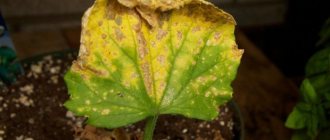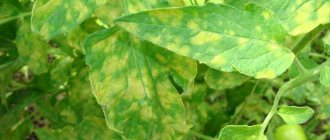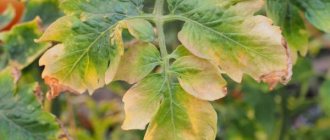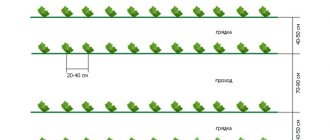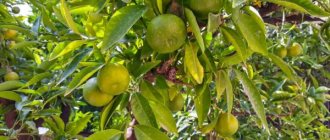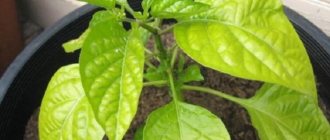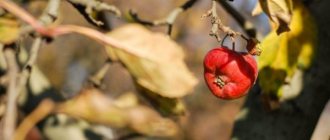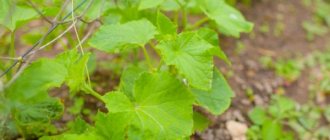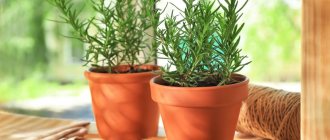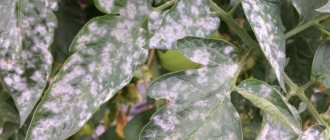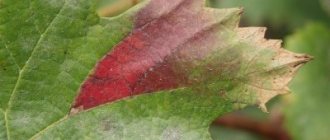Vegetable growing » Cucumbers
0
2396
Article rating
Kira Stoletova
Cucumber is a capricious crop, so growing it in the country or at home on the window sometimes turns into a challenge. There are many reasons why cucumbers turn yellow and dry on the windowsill. The main problem is that the seedling embryos do not really have time to bloom or the grown plants begin to dry out - this is insufficient or excessive lighting, improper feeding and watering.
Cucumbers turn yellow and dry on the windowsill
Symptoms and signs
The problem manifests itself through a number of signs, some of which are harbingers of yellowing. If pathology is detected in a timely manner, there is a chance to cope with it.
How does yellowing of cucumbers appear:
- seedling growth is inhibited;
- the stem becomes thinner;
- the color of the plant darkens or turns pale;
- spots of different colors and sizes appear;
- leaves curl, dry out and turn yellow;
- ovaries do not form or they fall off;
- the fruits do not grow, are deformed, have a bitter taste.
When seedlings stop growing, this serves as the main signal to begin combating the problem.
What causes the leaves and ovaries of cucumbers to turn yellow?
If not only the lower leaves, but also the upper leaves and ovaries of the cucumber turn yellow, it’s time to sound the alarm. If you do not take immediate action, you may lose your entire harvest.
1. Lack of sun is a common cause of yellowing of cucumber leaves and ovaries. Insufficient lighting of the lower leaves is not fatal for a cucumber, but if there is not enough light in the upper part of the plant, the problem must be solved quickly.
2. Hypothermia. In cold weather, the ovaries and leaves of cucumbers turn yellow and as a result may dry out.
3. Mineral deficiency. Most often, cucumbers lack nitrogen and potassium, which are washed out of the soil with frequent watering. Make up for this deficiency with complex mineral supplements.
Optimal temperature conditions for growing cucumbers: before fruits appear during the day in clear weather 22-24°C, in cloudy weather – 20-22°C, at night – 17-18°C; during fruiting during the day in clear weather 23-26°C, in cloudy weather - 21-23°C, at night - 18-20°C.
Why do cucumber leaves turn yellow?
Failures in the development of culture manifest themselves at different stages. This usually occurs due to excess moisture, lack of minerals, disease or pest attacks.
Main reasons:
- Wrong variety selected. For growing cucumbers on a windowsill, varieties are suitable that are undemanding to light, have early ripening periods, have a long fruiting period, are self-pollinating, disease-resistant and have a determinant growth type. If you ignore the above requirements, you will have to deal with the problem of yellowing leaves and inhibited harvest.
- Use when planting low-quality seeds. Cucumbers will grow weakly, be sick, not form fruits, or they will be bitter, deformed, and small.
- Illiterate care. At home, timely watering, fertilizing, treatment against infections and harmful beetles, and providing support for tying up the growing stem are required. Cucumbers need to be watered with settled water and additionally sprayed with a spray bottle. Due to the support, twisting of the stems is prevented and access of light and oxygen to all parts of the cucumber is ensured.
- Chlorophyll deficiency. To eliminate the problem, the bushes are fertilized with complex compounds that contain nitrogen, iron, and magnesium.
- Diseases or parasites. To ensure the absence of beetles, the plants are carefully inspected. Insects can be carried with the ground. The leaves curl, dry out, and die. The plant is treated with insecticides and garlic tincture to kill insects. Diseases should be fought after establishing a “diagnosis” by using the right drug.
- Sprout fly. The insect is gray in color with a stripe on the abdomen. It has white larvae that overwinter in the ground. It is necessary to change the soil when they are detected.
- Root rot. This is a fungal disease that causes rotting of the rhizome, drying out and yellowing of the leaves. Soon the bushes die. To prevent pathology, the soil should not be allowed to become too dry or waterlogged. If this happens, pour fresh soil into the container to form new adventitious rhizomes.
Diseases and beetle attacks rarely occur when cucumbers are grown indoors. More often, the leaves turn yellow due to the wrong variety and improper care.
Causes of drying and yellowing of leaves of seedlings and adult bushes
Disturbances in plant development can appear at any stage. Many reasons can lead to yellowing and drying of leaves: lack of minerals, excess moisture, disease infection.
Wrong variety of cucumbers selected
To reap a good harvest of cucumbers, you need to choose the right variety. Varieties with the following characteristics are suitable for growing crops on a windowsill:
- parthenocarpic or self-pollinating;
- not demanding of light;
- early harvest ripening;
- long fruiting period;
- resistance to diseases and pests;
- determinant type of growth.
If you do not take into account all these requirements, you will have to spend a lot of time and effort to preserve the harvest.
How to care for cucumbers correctly
The procedure for caring for homemade cucumbers is simple. It is necessary to draw up a diagram of the following actions:
- watering;
- fertilization;
- treatment against infections and pests;
- organization of support for tying up a growing stem.
Water the plant only with warm, settled water. Regularly spray with a spray bottle.
The support device will prevent the stem from twisting and provide free access of light and air to all parts of the plant.
Bacterial yellowing of cucumbers
Bacteriosis is considered a common bacterial disease of cucumbers on the windowsill. Bacteria attack any part of the plant.
The infection can be identified by a number of symptoms:
- the leaves begin to turn yellow starting from the lower rows;
- dark brown spots appear on the leaf blade;
- there is a whitish liquid on the inside;
- the fruits are deformed.
When the first signs of the disease are detected, it is necessary to remove the damaged areas and treat all plantings with Bordeaux mixture, copper oxychloride, as well as drugs such as Fitolavin, Kuproxat.
Fungal diseases
Fungal infection spreads at high speed; if the problem is not recognized in time, you can lose the entire harvest. Cucumbers are often infected with diseases such as:
- the fungus that causes powdery mildew affects any part of the bush, and as a result it begins to dry out, turn white, and become covered with a coating reminiscent of flour;
- gray rot is accompanied by the appearance of gray spots, which over time leads to withering and rotting of the plant;
- white rot can be recognized by white growths that look like cobwebs; the leaves become pale in color, begin to wither, curl and rot;
- root rot by wilting of the plant, dried leaves, dark spots, flowers and ovaries fall off, the root part becomes thinner and dries;
- the disease peronosporosis begins with yellowing of the leaves, they become covered with yellow-brown spots and curl upward, the embryos fall off and rot;
- Anthracnose manifests itself as brown spots on the leaves, deep spots on the stem and green shoots, gradually the leaves turn yellow, dry out and fall off.
See also
Description of the Amur cucumber variety, features of cultivation and care
Read
At the initial stage of the disease of cucumber bushes, it is permissible to use folk recipes. Compositions based on whey, wood ash are popular; a solution of Bordeaux mixture or copper sulfate helps.
If the plant is severely affected by a fungal infection, then it should be treated with chemicals such as Oxychom, Fundazol, Bayleton, and Topaz.
Imbalance of nutrients in the soil
In order for cucumbers on the loggia to develop normally, the soil must have a certain set of microelements. If there is a deficiency or excess of at least one component, problems with the growth and development of the plant may occur:
- Excess nitrogen is manifested by a change in the color of the leaf blade. It acquires a dark green color, yellow or grayish spots are observed. The fruits become small and the level of nitrates in them increases. Lack of nitrogen causes the stem to thin and the plant looks weak and lethargic.
- If the leaves darken and curl, you may suspect excess magnesium. In this case, calcium stops being absorbed and the roots die. Magnesium deficiency can be recognized by yellow leaves. Light spots appear on the leaves of the lower row.
- The growth of cucumbers stops in case of excessive potassium application. The leaves turn pale, wither, and spots appear. As a result of a lack of potassium, the edges of the leaves turn yellow, the cucumber forms an irregular shape, and the shoots quickly wither and fall off.
- Excess calcium makes the plant hard and brittle. Leaves may turn yellow or white. With calcium deficiency, white stripes appear, the leaves gradually wither and fall off. Rot is detected on any parts of the plant, which quickly spreads to the roots.
- With an excess of phosphorus, the leaf blade turns yellow and whitish spots form. Phosphorus deficiency is characterized by dry, yellow spots on the inside of leaves, flowers and ovaries fall off.
Yellowing of cucumbers on the windowsill can also be a concern if the balance of microelements such as boron, copper, sulfur, manganese, iron, zinc is disturbed.
Deficiency or excess moisture
The main reason for yellowing and wilting of cucumber leaves is improper or insufficient watering. The vegetable crop prefers moist soil, but there is no need to flood the roots. Excess moisture interferes with the flow of air, and the roots begin to rot. In addition, excess moisture causes fungal diseases.
Lack of moisture leads to the fact that soil microorganisms stop their activity, and plants do not receive enough nutritional components. The cucumber leaf becomes limp and begins to turn yellow.
In order to check that the reason is related to improper watering, you need to dig the ground to a depth of 10 cm. If it is dry, then you need to water in the recommended volume (you cannot increase the volume, trying to make up for the lack of water from previous days). In the case of waterlogging, it is better to transplant the seedlings into another container.
Balcony cucumbers” width=”600″ height=”419″ />
Watering the cucumbers is enough once a week. During the period of ovary formation and flowering, the frequency of irrigation is increased.
Too much or insufficient lighting
If the leaves of cucumbers on the balcony turn yellow, it is likely that they do not have enough light. In this case, you can correct the situation by moving the container with seedlings to a lighter windowsill. If this is not possible, you should organize an additional source of lighting (phytolamps or fluorescent lamps are suitable).
Cucumber bushes should be protected from direct sunlight. They can burn cucumber leaves. As a result, they curl, dry out, and stains appear. During midday, window shading is recommended.
Hypothermia
A decrease in the air temperature in the room leads to a slowdown in metabolic processes in the plant, and it begins to wither. The soil temperature in the root zone should not fall below +17 degrees. If the temperature has been low for a long period, the plant loses its ability to absorb nutrients.
As a result of hypothermia, the growth of seedlings stops, then the leaves begin to turn yellow at the tips and dry out. Gradually the entire plant dies. You can save cucumbers by moving the pots to a warm place.
Injuries to cucumber roots
Both pests and vegetable growers themselves can injure the roots of cucumbers during picking or loosening the soil. In this case, the leaves begin to turn yellow and dry out.
See also
Characteristics of Atlantis f1 cucumbers and growing a hybrid
Read
If the cause of yellowing and wilting of the plant is an injury to the root system, you need to apply nitrogen fertilizers and hill up 2-3 cm.
Excessive number of ovaries
If more than 25 ovaries are formed on one stem, the plant will not be able to provide them with adequate nutrition. As a result, the leaves and ovaries of the plant dry out, turn yellow, look lethargic and begin to fall off.
Pest infestation
Pests often cause poor plant growth and low yields. The larvae may be found on the surface of untreated seeds or in untreated soil.
melon aphid
Aphids are small in size. The color of the insect varies: yellow, black, brown, green. It feeds on the juice of young shoots. As a result, the plant slows down its development, the leaves turn yellow and dry out. The danger of aphids is that they carry viral diseases.
Spider mite
The small pest is colored bright red. The length of the body is no more than 0.6 mm. It is located on the inside of the leaf blade and feeds on plant sap.
Clear signs of the pest are whitish spots and milky cobwebs on the inside of the leaf. Gradually, the leaves begin to turn yellow, curl and dry out.
Greenhouse whitefly
The whitefly is a white winged insect with a body no larger than 4 mm. Signs of the pest include the formation of a sticky whitish coating on the leaves. Gradually the leaves turn yellow, become deformed and dry out.
Nutritional deficiencies
In organic matter, some useful components are found in small quantities. When cucumbers do not receive enough minerals, their leaves turn yellow.
What basic elements are required for cucumbers:
- Nitrogen. The component is found in urea, ammonium nitrate, and urea. Excess nitrogen leads to unreasonable growth of the cucumber crop. Many ovaries are formed, the leaves acquire a juicy dark green tone. Even if they dry on the windowsill, you can correct the situation with regular watering. Nitrogen is washed out of the ground by water.
- Calcium. An excess of this substance makes cucumbers brittle and tough. They may turn yellow or turn white. When there is not enough calcium, whitish stripes appear on the crop, the leaves wither and fall off. Traces of rot are found on any parts of the plant, quickly spreading through the roots.
- Phosphorus. The substance is responsible for the formation of rhizomes and the quality of nutrition of the crop. When there is not enough of it, the foliage of the seedlings turns yellow and they starve. Stem growth is inhibited, fewer ovaries are formed, and productivity decreases. Excess of the substance interferes with the absorption of potassium. As a treatment, they resort to a balanced supply of nutrients.
- Magnesium. If there is an excess of the substance, the leaves darken and curl up. The plant stops absorbing calcium, the roots die. Magnesium deficiency is identified by yellow cucumber leaves. Light spots are still visible on them.
- Potassium. The element delivers nutrients to every cell of the plant. It gives the fruits a pleasant taste and juiciness. When there is not enough potassium, the shoots turn yellow and dry out. Replenish its deficiency with potassium sulfate or potassium magnesium. The substance also stimulates the protective properties of the crop. Potassium deficiency is determined by symptoms such as drying of leaf edges, excessive growth of vines, almost no ovaries forming, and the fruit is watery and has a bitter taste.
With timely fertilization of cucumbers with mineral compounds, the risk of yellowing is minimized.
Causes of yellowing
You can decide what to do if the leaves of cucumbers turn yellow when grown on a windowsill after accurately identifying the cause of the negative changes. Various disturbances in the development of cucumber bushes appear at any stage of the growing season. The leaves become yellow and dry due to grower mistakes, incorrectly selected varieties, diseases and pest attacks.
Unsuitable variety
Not all varieties of cucumbers are capable of producing a good harvest when grown in a window. Varieties with the following characteristics are suitable for planting in an apartment:
- self-pollinating varieties or parthenocarpics;
- not needing a lot of light;
- having a short period of fruit ripening;
- bearing fruit for a long time;
- having good immunity to diseases and pests;
- growing according to the determinant type.
These are the minimum requirements for the variety to obtain a rich harvest of greens. Ignoring recommendations forces the vegetable grower to put a lot of effort in the fight for the harvest.
Diseases of cucumber seedlings and adult plants
Bacteriosis is one of the common diseases that affects vegetables when grown at home. Any part of the plant can be infected with bacteria. To identify an infection, pay attention to the condition of the cucumber bush. Infection can be detected by the following signs:
- yellowed leaves are concentrated in the lower part of the bush;
- the tops become covered with dark brown spots;
- there are wet whitish spots on the back of the leaves;
- Greens grow deformed.
Having discovered cucumbers with suspicious symptoms, all damaged areas are immediately removed and destroyed. All bushes in the garden are sprayed with Bordeaux mixture, copper oxychloride solution, or Kuproxat or Fitolavin preparations.
Too much or insufficient lighting
Often the leaves turn yellow due to lack of light. They correct the situation by moving the container with seedlings to a more illuminated windowsill. When this is not possible, it is necessary to organize an additional light source. Use phytolamps or fluorescent lamps.
It is important to protect cucumber bushes from direct ultraviolet rays, as they can burn the leaves. They curl, fade, and stains form on them. At noon, it is advisable to shade the windows with blinds.
Yellowing of cucumber leaves in a greenhouse
Many gardeners are engaged in growing cucumbers indoors, and many of them have probably encountered at least once that the foliage unexpectedly turns yellow. However, not everyone knows what causes this phenomenon and what needs to be done to prevent it in the greenhouse.
Did you know? It turns out that the first greenhouse cucumbers appeared in Ancient Rome because the Roman ruler Tiberius expressed a desire to see a fresh, crisp vegetable on his table every day.
Why does this happen
The reasons for the yellowness and drying of leaves of cucumbers in a greenhouse are similar to the previous cases, although they have their own specifics:
- The first and main reason is most often simple cold. Often, after planting a vegetable in a greenhouse, frosts occur, and, as we already know, a sharp drop in temperature not only affects the leaves, but also inhibits the growth of the plant as a whole and reduces its resistance to viruses and parasites.
- Another probable reason may be the climate does not meet the requirements of agricultural technology. For example, insufficiently intensive watering in combination with high air temperature in the greenhouse - cucumbers do not tolerate heat and low humidity and slow down their growth and development.
- Lack of microelements in the soil.
The cause of damage to the leaf plate of cucumbers can be plant pests: aphids, midges, spider mites.
What to do
It is necessary to provide additional insulation of the greenhouse in case frost returns. Maintain an adequate microclimate in the room: moderate temperature at all times, high humidity, ventilation. Periodically feed plants with microelements; you can use any industrially produced universal mineral fertilizer
It is important to remember that the reason for the deterioration of the foliage of a plant may be associated with the manifestation of diseases characteristic of a given crop: powdery mildew, root rot, bacteriosis, and a number of other diseases of a fungal nature. To combat these diseases, industrial fungicidal agents are used in parallel with the normalization of humidity and the removal of affected plants.
Deficiency or excess moisture
A common cause of yellowing and wilting of leaves in cucumber seedlings is illiterate or insufficient watering. The culture prefers moist soil, but the rhizomes should not be flooded. Excess moisture prevents the supply of oxygen, and the roots begin to rot. Too frequent watering also causes the development of fungal diseases. Lack of moisture entails the cessation of the activity of soil microorganisms, and plants lack nutritional components. Cucumber leaves become limp and turn yellow.
To make sure that the cause of the problem is improper watering, you need to dig the soil to a depth of 10 cm. If the soil is dry, you should water it abundantly, avoiding stagnation of water. When the leaves turn yellow due to waterlogging, the cucumbers should be transplanted into another container. They need to be watered once a week. During the formation of ovaries and flowers, the frequency of irrigation is increased.
Top dressing
If cucumbers are watered correctly and appropriate temperature conditions are created for them, they will not turn yellow. If they dry out, then the reason is most likely a deficiency of nutrients. During the season they need to be fertilized several times with organic and mineral fertilizers. Yellowing of the edges of the leaves is the first sign of improper plant development. There is a very effective way of feeding using mullein. Making a nutrient solution is simple. To do this, take 1 kg of manure and add 3 liters of water, leave to infuse for several days. Then strain the mixture and add more water. Water the cucumbers with this solution.
Mineral fertilizers
If potassium is added excessively, cucumbers stop growing, the leaves become pale, lethargic, and spots appear on them. If it is missing, the edge turns yellow, the fruits take on an irregular shape, and the stems quickly wither. Potassium is the element that makes greens crispy and juicy. You can replenish the deficiency with potassium magnesium or potassium sulfate.
Excess phosphorus leads to yellowed leaf blades on which white spots form. In this situation, the plant does not absorb potassium. It is necessary to treat with a balanced application of fertilizers. The lack of an element makes itself felt by the appearance of dry yellow spots on the inside of the leaves. Flowers and ovaries fall off. Phosphorus is responsible for nutrition and root formation. If there is a deficiency, adding superphosphate to the soil will help.
With excess nitrogen, the leaf blades become dark green with grayish or yellow spots. As for cucumbers, they become smaller and there is an increase in nitrate levels. Nitrogen deficiency leads to thinning of the shoots, the plant becomes lethargic and weak. The best sources include:
- urea;
- ammonium nitrate;
- urea.
To replenish the lack of nitrogen, use a solution of 1 tsp. nitrophoska per 3 liters of water, add 1 tbsp. wood ash.
With an excess of magnesium, the color of the leaves changes to darker. The plant cannot absorb calcium, this leads to the death of the roots. Yellow leaves are a consequence of a lack of magnesium. Light spots can be observed on the lower ones.
Due to excessive amounts of calcium, the plant becomes brittle and tough. The lack of this element leads to the appearance of rot on any parts. She immediately goes to the roots. The leaves may turn white or yellow and become covered with white stripes. Then they gradually weaken and fly around.
Attention!
For the normal development of cucumbers on an apartment balcony, the necessary microelements must be present in the ground.
If at least one element is missing, or there is an excess, problems will arise with the growth of the plant. The addition of mineral compounds is of great importance for the development of plants.
Organic fertilizers
In organic matter, individual elements are present in negligible quantities. The most common fertilizer of this type is manure. They prefer to use it because of its natural composition. When using manure, it is almost impossible to overfeed the plant with nutrients. It can be used dry, then dug up along with the soil or placed near the plantings, and when watered, the cucumbers will take away useful substances from it. Liquid fertilizer is also very good. After regular watering, the color of the yellowed leaves will change and they will turn green again.
Hypothermia
A decrease in air temperature in the room entails inhibition of metabolic processes in the crop, causing it to wither. In the root zone, the soil should be heated to at least +17 degrees. When coolness prevailed in the room for a long time, cucumber seedlings will stop absorbing nutrients. Due to hypothermia, the growth of bushes is inhibited, the tips of the leaves turn yellow and dry out. Over time, the plant dies. You can save cucumbers by moving the container with them to a warm place.
How can you help cucumbers that turn yellow on the windowsill?
So, we seem to have sorted out the question of what to do when cucumbers turn yellow. It remains to be seen how else to help the cucumber so that it can continue to grow and bear fruit. You can use different means, the main of which is fertilizing and fertilizers.
Topaz
Used for the prevention and treatment of various diseases and pests (powdery mildew, rust, aphids, midges, and so on). Treat your shrubs periodically (once a month is enough) to keep them healthy. So to speak, this is a kind of shield for the plant. Sold in ampoules. To obtain the desired solution, one ampoule is diluted in 10 liters of water. Next, the cucumbers need to be sprayed. There is no need to repeat the processing.
Oksikhom
Used for the prevention and treatment of various types of fungal diseases. Diluted in the proportion of 30 g of product per 10 liters of water. If you are treating for preventive purposes, then carry out the first procedure before flowering. Then spray twice more with an interval of 10-14 days. If treatment is needed in order to get rid of the fungus, then up to 5 treatments will be needed with an interval of 7-10 days.
Quadris
It also performs a protective function against ailments (powdery mildew, late blight, mildew and oidium). Apply it when the foliage of the plant has not yet turned yellow. Suitable even for seedlings. If used this way, it will help the bush in growth and development. Will increase flowering and fruiting. To prepare the working fluid, dilute 0.6 liters of product in 10 liters of water. Then spray the crop. There is no need to repeat the procedure.
For information on how and with what to carry out early feeding, watch the following video:
Top dressing
The following were added as fertilizers:
- Urea (1 tbsp) with superphosphate (60 g) and all this was diluted in 10 liters of water. Then she added it to the root part of the cucumbers. Accelerates the growth and development of plants.
- 5 g of ammophos for one bush. All you need to do in this case is tie the granules into the soil. They will dissolve on their own over time and saturate the soil with useful microelements.
- A mixture of ammonium nitrate, superphosphate and potassium salt (10 g in total). Then I threw it into 10 liters of water, stirred it and spilled it. Fertilizer promotes abundant fruiting.
It is impossible to apply both mineral and organic fertilizers at the same time
Fitosporin
It also serves to prevent both fungal and bacterial diseases. Its advantage is ease of use. Sold in liquid form immediately in working condition. That is, there is no need to breed - water the bushes immediately.
Folk fertilizers
Well, where would we be without traditional methods? For cucumbers I often use the following fertilizers:
- slurry diluted in a concentration of 1 to 8 with water. This feeding helps the plant absorb minerals faster.
- tincture on green grass for watering. It’s easy to prepare—gather some herbs and add hot water at the rate of 1 part herbs to 5 parts liquid. We left it to brew for 10-12 hours, strained and fertilized. This promotes the formation of green mass and flowers.
- chicken droppings. Diluted in a concentration of 1 to 15 with water. It is best to use only fresh. Thanks to this fertilizing, plant immunity increases.
If you think that such feeding is not enough, then find out what else to feed cucumbers on the windowsill. In the article you will find many useful options.
Pest treatment
There are many effective recipes for exterminating harmful insects:
- To eliminate aphids, use garlic tincture, ash and soap solution. If home remedies turn out to be ineffective, they resort to chemicals - “Commander”, “Korado”, “Aktara”.
- Spider mites are removed with Bordeaux mixture, ammonia, hydrogen peroxide, and tobacco dust. Among the effective biological products are “Akarin”, “Aktofit”, “Fitoverm”. In extreme situations, chemical agents are used.
- The whitefly is destroyed by such means as “Aktara”, “Iskra”, “Akarin”. You can also use tincture of dandelion, yarrow, soap solutions, wood ash and garlic.
In case of severe damage to cucumber seedlings by beetles, they are disposed of. It is important to promptly remove the infected container, otherwise the insects will spread to healthy bushes.
Treatment
When yellow leaves appear on cucumber bushes, the conditions of maintenance are adjusted and the care of the plants is reviewed. Additionally, the cucumbers are examined to determine if there are other symptoms.
If there are signs of nitrogen deficiency, the bushes are fed with a solution of ammonium nitrate. Fertilizers are applied twice, maintaining an interval of 5 days between procedures. If there is no improvement, nitroammophoska is added additionally. Cucumbers react poorly to a lack of nutrients and their excess content in the soil. Therefore, fertilizing is carried out according to a schedule taking into account the recommended standards.
Cucumbers need proper watering. In sunny and hot weather, plants are watered every day in the morning or evening. For irrigation, take warm, settled water. In cloudy weather, watering is reduced.
To treat diseases of cucumbers on the windowsill, folk remedies are used in case of slight spread of the disease:
- Spraying with a whey solution works well. The fermented milk product must be mixed with clean water in a ratio of 1:4 and sprayed on the plants from all sides.
- Mullein infusion effectively destroys fungus and at the same time serves as a supplement. Mix 1 kg of organic matter in 3 liters of clean water and leave to brew for 3 days. Then you need to make a working solution from the concentrate by adding an equal amount of water. They need to spray the cucumber tops.
To eliminate insects from folk remedies, use an infusion of garlic or a soap-ash solution. If there are a lot of pests and folk remedies do not give the desired effect, potent insecticides are used. To destroy aphids, use the product “Aktara”; “Commander” or “Korado” are also suitable.
You can destroy spider mites by treating the plants with an ammonia solution or Bordeaux mixture. For a small number of pests, a peroxide solution or tobacco dust helps. For better effect, you can use biological products “Fitoverm”, “Actofit”.
Against whiteflies, use an infusion of dandelions, treat with laundry soap or infusion of garlic. To improve the result, modern drugs are used, for example, Iskra, Akarin or Aktaru.
Important!
It is not advisable to use potent insecticides to treat balcony cucumbers. Even a small concentration of toxins in the air can harm health and lead to poisoning.
Folk ways to keep cucumber leaves healthy
The use of chemicals effectively eliminates yellowing of leaves, but sometimes they harm the plant itself.
Cucumbers on windowsills can also be cured using unconventional methods:
- Leaf yellowness is removed with a solution of kefir and whey. Nutrient components are diluted with water at the rate of 2:10. Cucumbers are sprayed with the prepared mixture regularly until their normal color returns.
- Water the soil with cucumber seedlings with water where fresh meat was washed.
- Cut freshly frozen capelin into pieces and dig into the ground.
You can also feed cucumbers with kefir, urea, and onion peel tincture to prevent yellowing of the leaves.
Prevention
To prevent the cucumber bushes on the windowsill from turning white and yellow, you must take care in advance of suitable conditions for growing them and follow all the rules of agricultural technology. At home, only suitable low-growing varieties with early ripening are grown. Before planting, be sure to disinfect the seed material and soil in which the bushes will grow. In boxes, bushes are placed at a distance from each other, avoiding thickening.
Throughout the season, cucumbers are watered regularly, avoiding waterlogging of the soil. They also provide plants with additional nutrition by periodically adding mineral fertilizers and organic matter. In this case, the types of fertilizing must be alternated in order to fully provide the plants with nutrients. In summer, it is necessary to ensure that the air temperature is within acceptable limits.
To prevent plants from turning yellow, it is recommended to spray them with a decoction of onion peels and ash infusion for preventive purposes. Mullein infusion, spraying with a solution of baking soda or whey works well on cucumbers.
Growing cucumbers on a windowsill will be successful if you take all measures in advance to avoid yellowing of the foliage. Proper care in compliance with all the rules of agricultural technology increases the chances of getting a good harvest of greens even in a limited balcony space.
Useful tips for gardeners
If you notice that the leaves of all the cucumbers on the windowsill are turning yellow, then immediately begin to figure out the problem. Many cucumber diseases can be solved in the early stages of the disease, without the use of chemicals. Harvesting fruits grown independently on the window should be carried out only after the cucumbers have fully ripened. Vegetables from your own garden, even if the perimeter of your growing area is limited by the size of the windowsill, retain much more nutrients, providing the body with health and longevity.
Fresh greens leave few people indifferent. However, not everyone has a plot of land. So cucumber lovers manage to grow them under the windows of high-rise buildings, if there is a piece of land, or even on balconies and window sills.
However, caring for cucumbers growing on windowsills is much more difficult than even in greenhouses. Too many nuances have to be taken into account so that the yellowness does not cover the foliage and the cucumbers are properly collected.
Planting cucumbers
There are two ways to plant cucumbers - through picking or the classic way. The first option (with replanting) is more troublesome, but usually allows you to get a richer harvest. The second one is simpler, but the number of cucumbers collected from the bushes is not too large.
Cucumbers on the windowsill. Growing
Picking means that first the sprouts are planted in small (about 100 ml) cups (preferably cardboard, from a farm store). They plant about twice as many seeds as they expect to get bushes - 4-5 grains in each glass. Some of them will not germinate, and some will produce weak sprouts due to lack of lighting or other reasons. The substrate used is the same as described above.
A week or two after the sprouts in the glasses hatch, picking is carried out. The weak ones are removed - one or two sprouts should remain in each glass. Choose the largest and neatest ones - they will give the best harvest. After another two weeks, the sprouts are transplanted. This is done simply - the soil is slightly moistened with water, after which it is carefully turned over onto the palm - the sprout should pass between the fingers. The cup itself is easily removed upwards, and the soil with the sprout is planted in a pre-prepared hole in a large pot.
Cucumber seedlings on the windowsill. Photo
If you prefer a simpler method of planting, without picking, then fill the pot about halfway with soil. Seeds are placed on it, which are sprinkled with 1-2 centimeters of soil. When the sprouts hatch, add soil so that it does not reach 2-3 millimeters to the edges (otherwise it will be inconvenient to water). Don’t worry if after a few weeks not all the sprouts hatch again - the weak ones will die so as not to draw out useful minerals from the soil.
What to do if the leaves dry out
If young leaves of cucumbers dry out in a greenhouse, then you need to reconsider the care system. Provide sufficient light and distance between beds. Special land is also required. The open ground used is not suitable for greenhouse plants. The soil needs a higher content of peat, wood components, and urea.
Already damaged thickets must be removed immediately. They are not capable of photosynthesis, but at the same time they continue to take nutrients from the growing bed. It is also important to maintain a water balance, otherwise the roots will begin to rot if they are flooded with water. The soil should not be dry, but slightly moist. Therefore, the air condition in the greenhouse is monitored. When it is dry, first only the edges of the cucumbers dry out, and then the root system and fruits.
Why a window sill?
People often wonder why they choose a window sill as a garden bed?
Cucumbers, like many plants, love light and sun. The window sill is the best place to receive sunlight. For better growth of cucumbers, choose a window sill facing south. It is here that the cucumbers will receive the necessary amount of heat, which is the basis for the growth and productivity of the crop.
It is important to prepare special soil. Usually they buy it in a store. But you can prepare it yourself using soil, peat, compost, sawdust, and fertilizer.

